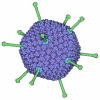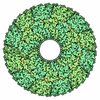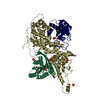[English] 日本語
 Yorodumi
Yorodumi- PDB-2qzh: SCR2/3 of DAF from the NMR structure 1nwv fitted into a cryoEM re... -
+ Open data
Open data
- Basic information
Basic information
| Entry | Database: PDB / ID: 2qzh | ||||||
|---|---|---|---|---|---|---|---|
| Title | SCR2/3 of DAF from the NMR structure 1nwv fitted into a cryoEM reconstruction of CVB3-RD complexed with DAF | ||||||
 Components Components | Complement decay-accelerating factor | ||||||
 Keywords Keywords | IMMUNE SYSTEM / SCR2-3 of DAF fitted into cryoEM density of CVB3-RD complexed with DAF / Alternative splicing / Blood group antigen / Complement pathway / Glycoprotein / GPI-anchor / Immune response / Innate immunity / Lipoprotein / Membrane / Polymorphism / Sushi | ||||||
| Function / homology |  Function and homology information Function and homology informationregulation of lipopolysaccharide-mediated signaling pathway / negative regulation of complement activation / regulation of complement-dependent cytotoxicity / regulation of complement activation / respiratory burst / positive regulation of CD4-positive, alpha-beta T cell activation / positive regulation of CD4-positive, alpha-beta T cell proliferation / Class B/2 (Secretin family receptors) / ficolin-1-rich granule membrane / COPI-mediated anterograde transport ...regulation of lipopolysaccharide-mediated signaling pathway / negative regulation of complement activation / regulation of complement-dependent cytotoxicity / regulation of complement activation / respiratory burst / positive regulation of CD4-positive, alpha-beta T cell activation / positive regulation of CD4-positive, alpha-beta T cell proliferation / Class B/2 (Secretin family receptors) / ficolin-1-rich granule membrane / COPI-mediated anterograde transport / complement activation, classical pathway / side of membrane / transport vesicle / endoplasmic reticulum-Golgi intermediate compartment membrane / secretory granule membrane / Regulation of Complement cascade / positive regulation of T cell cytokine production / virus receptor activity / positive regulation of cytosolic calcium ion concentration / membrane raft / Golgi membrane / innate immune response / lipid binding / Neutrophil degranulation / cell surface / extracellular exosome / extracellular region / plasma membrane Similarity search - Function | ||||||
| Biological species |  Homo sapiens (human) Homo sapiens (human) | ||||||
| Method | ELECTRON MICROSCOPY / single particle reconstruction / cryo EM / Resolution: 14 Å | ||||||
 Authors Authors | Hafenstein, S. / Bowman, V.D. / Chipman, P.R. / Bator Kelly, C.M. / Lin, F. / Medof, M.E. / Rossmann, M.G. | ||||||
 Citation Citation |  Journal: J Virol / Year: 2007 Journal: J Virol / Year: 2007Title: Interaction of decay-accelerating factor with coxsackievirus B3. Authors: Susan Hafenstein / Valorie D Bowman / Paul R Chipman / Carol M Bator Kelly / Feng Lin / M Edward Medof / Michael G Rossmann /  Abstract: Many entero-, parecho-, and rhinoviruses use immunoglobulin (Ig)-like receptors that bind into the viral canyon and are required to initiate viral uncoating during infection. However, some of these ...Many entero-, parecho-, and rhinoviruses use immunoglobulin (Ig)-like receptors that bind into the viral canyon and are required to initiate viral uncoating during infection. However, some of these viruses use an alternative or additional receptor that binds outside the canyon. Both the coxsackievirus-adenovirus receptor (CAR), an Ig-like molecule that binds into the viral canyon, and decay-accelerating factor (DAF) have been identified as cellular receptors for coxsackievirus B3 (CVB3). A cryoelectron microscopy reconstruction of a variant of CVB3 complexed with DAF shows full occupancy of the DAF receptor in each of 60 binding sites. The DAF molecule bridges the canyon, blocking the CAR binding site and causing the two receptors to compete with one another. The binding site of DAF on CVB3 differs from the binding site of DAF on the surface of echoviruses, suggesting independent evolutionary processes. | ||||||
| History |
|
- Structure visualization
Structure visualization
| Movie |
 Movie viewer Movie viewer |
|---|---|
| Structure viewer | Molecule:  Molmil Molmil Jmol/JSmol Jmol/JSmol |
- Downloads & links
Downloads & links
- Download
Download
| PDBx/mmCIF format |  2qzh.cif.gz 2qzh.cif.gz | 29.6 KB | Display |  PDBx/mmCIF format PDBx/mmCIF format |
|---|---|---|---|---|
| PDB format |  pdb2qzh.ent.gz pdb2qzh.ent.gz | 14.5 KB | Display |  PDB format PDB format |
| PDBx/mmJSON format |  2qzh.json.gz 2qzh.json.gz | Tree view |  PDBx/mmJSON format PDBx/mmJSON format | |
| Others |  Other downloads Other downloads |
-Validation report
| Summary document |  2qzh_validation.pdf.gz 2qzh_validation.pdf.gz | 756.7 KB | Display |  wwPDB validaton report wwPDB validaton report |
|---|---|---|---|---|
| Full document |  2qzh_full_validation.pdf.gz 2qzh_full_validation.pdf.gz | 758.3 KB | Display | |
| Data in XML |  2qzh_validation.xml.gz 2qzh_validation.xml.gz | 10.7 KB | Display | |
| Data in CIF |  2qzh_validation.cif.gz 2qzh_validation.cif.gz | 14.3 KB | Display | |
| Arichive directory |  https://data.pdbj.org/pub/pdb/validation_reports/qz/2qzh https://data.pdbj.org/pub/pdb/validation_reports/qz/2qzh ftp://data.pdbj.org/pub/pdb/validation_reports/qz/2qzh ftp://data.pdbj.org/pub/pdb/validation_reports/qz/2qzh | HTTPS FTP |
-Related structure data
| Related structure data |  1412MC  1411C 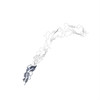 2qzdC  2qzfC M: map data used to model this data C: citing same article ( |
|---|---|
| Similar structure data |
- Links
Links
- Assembly
Assembly
| Deposited unit | 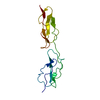
|
|---|---|
| 1 |
|
- Components
Components
| #1: Protein | Mass: 14351.303 Da / Num. of mol.: 1 / Fragment: SCR2/3 domains Source method: isolated from a genetically manipulated source Source: (gene. exp.)  Homo sapiens (human) / Production host: Homo sapiens (human) / Production host:  Pichia pastoris (fungus) / References: UniProt: P08174 Pichia pastoris (fungus) / References: UniProt: P08174 |
|---|
-Experimental details
-Experiment
| Experiment | Method: ELECTRON MICROSCOPY |
|---|---|
| EM experiment | Aggregation state: PARTICLE / 3D reconstruction method: single particle reconstruction |
- Sample preparation
Sample preparation
| Component |
| |||||||||||||||
|---|---|---|---|---|---|---|---|---|---|---|---|---|---|---|---|---|
| Buffer solution | pH: 6 / Details: 50mM MES | |||||||||||||||
| Specimen | Conc.: 2 mg/ml / Embedding applied: NO / Shadowing applied: NO / Staining applied: NO / Vitrification applied: YES | |||||||||||||||
| Specimen support | Details: quantifoils | |||||||||||||||
| Vitrification | Instrument: HOMEMADE PLUNGER / Cryogen name: ETHANE / Details: blot before plunging |
- Electron microscopy imaging
Electron microscopy imaging
| Microscopy | Model: FEI/PHILIPS CM300FEG/T / Date: Aug 6, 2004 |
|---|---|
| Electron gun | Electron source: TUNGSTEN HAIRPIN / Accelerating voltage: 300 kV / Illumination mode: FLOOD BEAM |
| Electron lens | Mode: BRIGHT FIELD / Nominal magnification: 45000 X / Nominal defocus max: 4.6 nm / Nominal defocus min: 1 nm / Cs: 2 mm |
| Specimen holder | Temperature: 93 K / Tilt angle min: 0 ° |
| Image recording | Electron dose: 24 e/Å2 / Film or detector model: KODAK SO-163 FILM |
| Radiation | Protocol: SINGLE WAVELENGTH / Monochromatic (M) / Laue (L): M |
| Radiation wavelength | Relative weight: 1 |
- Processing
Processing
| EM software |
| ||||||||||||
|---|---|---|---|---|---|---|---|---|---|---|---|---|---|
| Symmetry | Point symmetry: I (icosahedral) | ||||||||||||
| 3D reconstruction | Resolution: 14 Å / Num. of particles: 2269 / Symmetry type: POINT | ||||||||||||
| Atomic model building | PDB-ID: 1NVW Accession code: 1NVW / Source name: PDB / Type: experimental model | ||||||||||||
| Refinement step | Cycle: LAST
|
 Movie
Movie Controller
Controller


 UCSF Chimera
UCSF Chimera

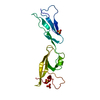

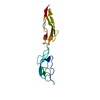
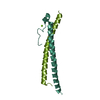
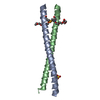
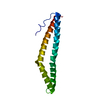
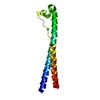
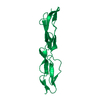
 PDBj
PDBj